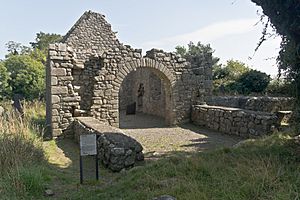Meic Torcaill facts for kids
The Meic Torcaill were a powerful family in Dublin long ago. They were a Norse-Gaelic family, meaning they had both Norse (Viking) and Gaelic (Irish) roots. This family produced several important leaders, including some kings of Dublin.
However, their power changed a lot after the Normans conquered Dublin in 1170. The Meic Torcaill family lost much of their land and influence. Over time, other families in Dublin, like the Harolds and Archbolds, became more important than them.
The Meic Torcaill in Dublin's History
| Simplified family tree showing some possible leaders of the Meic Torcaill family in Dublin. | |||||||||||||||||||||||||||||||||||||||||||||||||||||||||||||||||||||||||||||||||||||||||||||||||||||||||||||||||||||||||||||||||
|---|---|---|---|---|---|---|---|---|---|---|---|---|---|---|---|---|---|---|---|---|---|---|---|---|---|---|---|---|---|---|---|---|---|---|---|---|---|---|---|---|---|---|---|---|---|---|---|---|---|---|---|---|---|---|---|---|---|---|---|---|---|---|---|---|---|---|---|---|---|---|---|---|---|---|---|---|---|---|---|---|---|---|---|---|---|---|---|---|---|---|---|---|---|---|---|---|---|---|---|---|---|---|---|---|---|---|---|---|---|---|---|---|---|---|---|---|---|---|---|---|---|---|---|---|---|---|---|---|---|
|
|||||||||||||||||||||||||||||||||||||||||||||||||||||||||||||||||||||||||||||||||||||||||||||||||||||||||||||||||||||||||||||||||

We don't know exactly where the Meic Torcaill family came from. Some historians think they might be linked to a man named Torcall mac Éola, who died in Wales in 1093. His son, Torfind mac Torcaill, died in 1124. These men might have been early ancestors of the family.
The Meic Torcaill family definitely became important in the early 1100s. The first known member was a man named Torcall. He seems to have become powerful around 1133. At this time, Dublin was closely connected to Diarmait Mac Murchada, King of Leinster (who died in 1171).
However, Diarmait lost control of Dublin in 1141. Historical records show that Conchobar Ua Briain, King of Munster (who died in 1142) took over the town. After Conchobar was removed, the people of Dublin chose an Islesman named Ottar mac meic Ottair (who died in 1148) as their king in 1142.
During this time, the leader of the Meic Torcaill family was likely Torcall's son, Ragnall (who died in 1146). Records mention that a son of an unnamed Meic Torcaill member was killed in 1138. If this was Ragnall's son, it might have weakened the family. This could have allowed the Meic Ottair family to gain power.
Kings of Dublin
In 1146, several old books say that Ragnall was killed. They call him the King of Dublin. If this is true, Ragnall's rule would have started after 1144 and interrupted Ottar's reign. Ottar himself died as king in 1148. However, some records call Ragnall a mórmáer, which means he might have been a leader under Ottar.
Even if Ottar and the Meic Torcaill worked together at first, historical accounts show that the Meic Torcaill family was responsible for Ottar's death in 1148.
The next king from the Meic Torcaill family was Ragnall's brother, Brodar (who died in 1160). He was killed in 1160 by another family from South Brega.
After Diarmait Mac Murchada gained control over Dublin again in 1162, he gave land to churches. One gift, made between 1162 and 1166, was for the lands of Baldoyle. Several Meic Torcaill family members, Echmarcach and Aralt, witnessed this gift.
The last King of Dublin from this family was Ragnall's son, Ascall (who died in 1171). In 1167, records mention a Ragnall mac Ragnaill, called "lord of the foreigners," attending a big meeting. This might have been Ascall himself, or an unknown brother.
In 1170, Ascall was driven out of Dublin by the forces of Richard de Clare, also known as Strongbow. The next year, Ascall tried to take Dublin back but was defeated. Many Irish records say he died in this battle. However, other sources say he was publicly executed.
Loss of Power and Lands

Before Dublin fell, the Meic Torcaill family owned a lot of land. After Ascall was defeated, a document shows he had given the church of St Brigid and its lands to the Church of the Holy Trinity. Another family member, Sitric, also gave the church and lands of Tully to the same church.
When the last Meic Torcaill king fell and the English took control of Dublin, the family's lands were taken away. They lost land from Tully all the way to Bray, and up to Glencullen. These lands were given to a man named Walter de Ridlesford. This included a large part of the area known as "Odurchill," which was the Meic Torcaill's territory in what is now south Dublin and north-east County Wicklow. The family also had lands in north Dublin, including Portrane, Malahide, Portmarnock, and Kilbarrack. Richard de Clare also gave lands that used to belong to the Meic Torcaill to St Mary's Abbey in Dublin.
However, not all was lost forever. In 1174, a man named Hamund Mac Torcaill and his brothers were allowed to keep their lands in Kinsealy. This shows that some leading Dublin families, including the Meic Torcaill, were slowly brought into the new English system. The Harold family was likely also treated this way around the same time.
As the Meic Torcaill family's power lessened, the Harolds and Archbolds became more important. A "G. Mactorail" witnessed a land grant between 1172 and 1181. Another Meic Torcaill member, Alan Mac Torcaill, witnessed a grant to St Mary's Abbey in Dublin during the same period.
The Meic Torcaill family might still be remembered in some Irish place names. For example, the earthwork called Rathturtle, near Blessington, probably comes from the Irish words Rath Torcaill. This means "Torcall's fort" and might refer to a family member. We don't know if it was a Viking fort because the site hasn't been dug up.
Another name that seems to refer to a Meic Torcaill member is in the townslands of Curtlestown Upper and Curtlestown Lower, near Powerscourt. Their Irish names, Baile Mhic Thorcail Uachtarach and Baile Mhic Thorcail Íochtarach, mean "Upper and Lower Town of Mac Torcaill."

